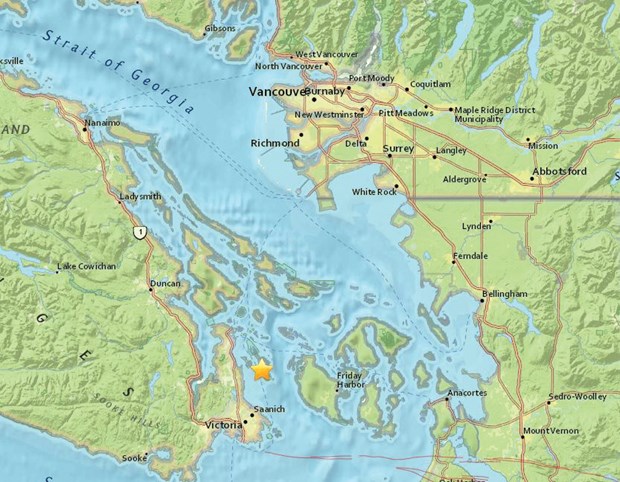It was tiny jolt as earthquakes go, but still the biggest one felt in the Lower Mainland in more than a decade.
Just before 11:40 p.m. Tuesday night, a piece of the relatively small Juan De Fuca plate slipped under the much larger North American plate about 50 kilometres below the surface, near Sidney on Vancouver Island.
Natural Resources Canada recorded the quake’s magnitude at 4.7. The United States Geological Survey put it at 4.8. Within about 10 seconds, the shaking was over and the reverberations began to spread on social media.
“I felt about five seconds of rumbling, then a bang, followed by a few seconds of rattling,” Johanna Mantsinen posted to Twitter from Lynn Valley following the quake.
Others reported more harrowing accounts.
“My Parkgate North Van 30-year-old townhouse shook and my chandelier was swinging and (there were) scary cracking sounds in walls and ceiling,” Louise Ranger tweeted.
Earthquakes that fall between four and five on the scale tend to be felt but typically don’t cause much damage, said Sheila Ross, physical geography instructor at Capilano University.
“In Vancouver there’s a huge amount of variation in the type of material that we’re sitting on and therefore it could vary from one place to another,” she said. “Here on the North Shore, most of us on are on bedrock. You feel less than you would if you were in Richmond at the floodplain of a river.”
The type of building you’re in will also impact how a quake feels, Ross said.
“I think you could feel it more in a concrete building than a wood building because concrete flexes less. It would be more jarring,” she said.
An earthquake measuring 4.3 or 4.8, is a fragment of what seismologists are expecting when the “big one” hits but it’s still likely the strongest one felt in the Lower Mainland since a 6.8-magnitude earthquake hit the southern end of Puget Sound in 2001.
Mike Andrews, emergency planning officer for the North Shore Emergency Management Office, was roused from bed by the tremor, kicking into action the team meant to help usher the North Shore through a crisis.
“Immediately my phone started ringing and I turned my radio on as per our standard operating procedure,” he said.
About an hour and a half later, after Andrews confirmed through his provincial counterparts there were no reports of damage or threats of a tsunami and the emergency management office had updated its website, Andrews went back to bed. On Wednesday, he was back in the emergency management office talking preparedness for when the many-thousand-times stronger subduction quake off the West Coast of Vancouver Island hits.
“Those occur every 200 to 600 years and we’re in the return cycle. The last one was Jan. 26, 1700 at 9 p.m.,” he said.
In April 2015, the District of North Vancouver released the results of a five-year study into what would happen when a 7.3 quake hits. It found at least 15,000 North Shore homes would be without water and power and more 4,000 people could be forced outside in the immediate aftermath. Up to 2,000 people are likely to be injured, overwhelming Lions Gate Hospital. Several hundred would likely be critically injured, or killed.
The emergency management office is making great progress in planning its response to such an event, including carrying out the largest-of-its-kind response drill in November, Andrews said, but it’s the rest of us who have been slack in putting together emergency kits and plans, he added.
“It’s unfortunate but because we haven’t had a damaging earthquake in recent memory, people feel it won’t happen. Trying to overcome that apathy and get people to prepare is a challenge,” he said.
Residents should have a readily accessible supply of clean water and non-perishable food, flashlights and batteries, blankets, a radio and medication for at least 72 hours, preferably a week, Andrews said.



